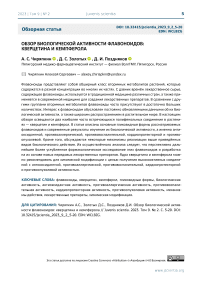Обзор биологической активности флавоноидов: кверцетина и кемпферола
Автор: Чиряпкин А.С., Золотых Д.С., Поздняков Д.И.
Журнал: Juvenis scientia @jscientia
Рубрика: Обзорные статьи
Статья в выпуске: 2 т.9, 2023 года.
Бесплатный доступ
Флавоноиды представляют собой обширный класс вторичных метаболитов растений, которые содержатся в разной концентрации во многих их частях. С давних времён лекарственное сырье, содержащее флавоноиды, используется в традиционной медицине различных стран, а также применяется в современной медицине для создания лекарственных препаратов. В сравнении с другими группами вторичных метаболитов флавоноиды часто присутствуют в достаточно больших количествах. Интерес к флавоноидам обусловлен постоянно обновляемыми данными об их биологической активности, а также широким распространением в растительном мире. В настоящем обзоре освещаются два наиболее часто встречающихся полифенольных соединения в растениях - кверцетин и кемпферол. В статье описаны основные гликозидные формы рассматриваемых флавоноидов и современные результаты изучения их биологической активности, а именно антиоксидантной, противоаллергической, противовоспалительной, кардиопротекторной и противоопухолевой. Кроме того, обсуждаются некоторые механизмы реализации выше приведённых видов биологического действия. Из осуществлённого анализа следует, что перспективно дальнейшее более углубленное фармакологическое исследование этих флавоноидов и разработка на их основе новых передовых лекарственных препаратов. Ядра кверцетина и кемпферола можно рекомендовать для химической модификации с целью получения высокоактивных соединений с антиоксидантной, противоаллергической, противовоспалительной, кардиопротекторной и противоопухолевой активностью.
Флавоноиды, кверцетин, кемпферол, гликозидные формы, биологическая активность, антиоксидантная активность, противоаллергическая активность, противовоспалительная активность, кардиопротекторная активность, противоопухолевая активность, механизмы действия, лекарственные препараты, химическая модификация
Короткий адрес: https://sciup.org/14128034
IDR: 14128034 | DOI: 10.32415/jscientia_2023_9_2_5-20
Текст обзорной статьи Обзор биологической активности флавоноидов: кверцетина и кемпферола
К перспективной группе полифенольных биологически активных соединений (БАС) с разнообразным спектром фармакологического действия относят флавоноиды, которые широко распространены в растениях в качестве вторичных продуктов их метаболизма. С химической точки зрения они представляют собой производные хромана (бензо- γ -пирана) или хромона (бензо- γ -пирона), содержащие в положениях 2, 3 и/или 4 арильный радикал, в основе строения которых лежит фенилпропановый скелет, состоящий из С6-С3-С6 углеродных единиц. Их структурное разнообразие и фармакологическая ценность обусловливает значимый интерес для разработки на их основе новых растительных лекарственных средств с низкой токсичностью [1]. В последние годы наблюдается увеличение количества фармакопейных растений, содержащих в качестве ведущей группы БАС флавоноиды и другие полифенольные соединения [2], что актуализирует фитохимические исследования и поиск новых растительных объектов с выраженными фармакологическими эффектами для терапии различных заболеваний.
КВЕРЦЕТИН, ЕГО ГЛИКОЗИДЫ И ДРУГИЕПРОИЗВОДНЫЕ
Кверцетин относится к одним из наиболее распространенных флавоноидов в растительных объектах и проявляет широкий спектр биологической активности, что обусловливает перспективность разработки на его основе лекарственных препаратов и синтеза новых фармакологически активных молекул. Наиболее распространенными формами кверцетина являются кверцетина глюкуронид, кверцетина сульфат и метилированный кверцетин [3]. Стоит отметить, что чаще всего данный флавоноид встречается в растениях в виде соединений, которые, как правило, содержат в своей структуре сахара. Например, рутин представляет собой гликозид, состоящий из кверцетина и дисахарида рутинозы. В случае замена гликона на галактозу формируется широко известное фенольное соединение — гиперозид. Такой гликозид кверцетина, как кверцитрин, содержит в свой структуре дезоксисахар рамнозу (рисунок 1). Таким образом, ядро кверцетина встречается в составе таких хорошо известных полифенольных соединений, как рутин и гиперозид, которые обладают разнообразными видами биологической активности [4]. Введение сахаров в структуру кверцетина, помимо влияния на его всасывание и фармакологический эффект, также изменяет его растворимость. Сам же кверцетин нерастворим в холодной воде, немного лучше растворяется в горячей воде и растворим в спиртах и липидах [5]. Считается, что на кверцетин и его гликозилированные формы приходится около 60–75% потребления флавоноидов c пищей человека [6].
БИОЛОГИЧЕСКАЯ АКТИВНОСТЬ КВЕРЦЕТИНА
Антиоксидантная активность
Для кверцетина характерна выраженная антиоксидантная активность. Это обусловлено его способностью легко окисляться до о-гидрохиноновой кислоты, которая далее превращается ферментами в о-хинон [7]. В связи с этим происходит нейтрализация свободных радикалов, оказывающих разрушительное действие на мембраны клеток. Реализация антиоксидантного действия возможна за счет содержания в кверцетине пяти гидроксильных групп. В результате такого строения кверцетин легко передает электроны свободным радикалам, что приводит к их стабилизации и нейтрализации разрушительного потенциала. Установлено, что кверцетин может участвовать в образовании хелатных комплексов с ионами металлов, инициирующими процесс перекисного окисления липидов. Тем самым кверцетин также оказывает опосредованное антиоксидантное действие [8]. Оценка общей антиоксидантной активности кверцетина фосфорномолибденовым методом выявила, что он в 3,5 раза превосходит по данному виду биологического действия куркумин [9]. Однако при высоких концентрациях кверцетина наблюдается обратный эффект. Так на примере клеточной линии А549 in vitro установлено, что происходит снижение содержания тиолов, общей антиоксидантной активности, каталазы, супероксиддисмутазы и глутатион-S-трансферазы. В итоге индуцируется окислительный стресс вследствие образования кверцетин кверцитрин кверцетина глюкуронид кверцетина сульфат
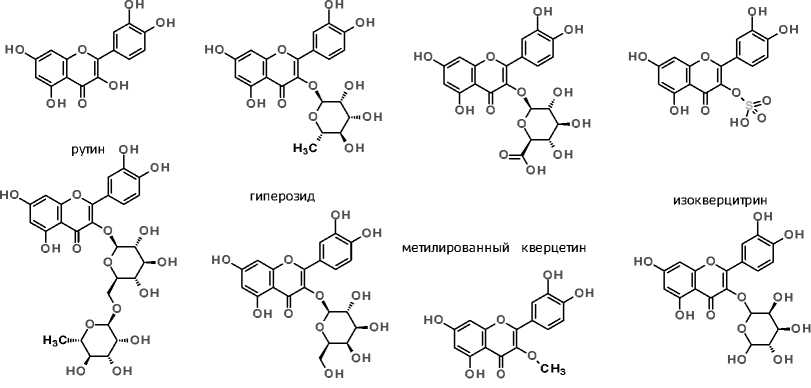
Рисунок 1. Наиболее распространенные формы кверцетина, включая его гликозиды
активных форм кислорода во внеклеточной среде [10]. Эндогенная антиоксидантная активность кверцетина благоприятно сказывается на снижении аллергического повреждения, вызванного активными формами кислорода. К тому же такие ферменты, как липазы, протеазы, трансферазы и ферменты репарации ДНК в комплексе с биологическим действием флавоноида восстанавливают поврежденные мембраны клеток организма [11, 12]. Противоокислительное действие кверцетина положительно влияет на остеобласты, подвергающиеся токсическому эффекту сигаретного дыма. Такая активность обусловлена способностью поли-фенольного соединения увеличивать экспрессию гемооксигеназы и супероксиддисмутазы, что снижает деструктивное воздействие на костную ткань и способствует заживлению переломов у курильщиков [13].
Противоопухолевая активность
В исследованиях Murakami и соавт. приводятся данные, что кверцетин может оказывать противораковое действие. При этом важно отметить, что он не проявляет практически никаких нежелательных эффектов, что позволяет рассматривать его как перспективное соединение с противоопухолевым действием. Например, он взаимодействует с рецепторами арильных углеродов, участвующими в формировании опухолей. На грызунах установлено, что прием данного флавоноида с пищей нивелирует химически индуцированный канцерогенез в толстой кишке [14]. Также совместное применение кверцетина и ресвератрола показало многообещающие результаты для терапии рака толстой кишки, индуцированного азоксиметаном на модели крыс [15]. Лечение цисплатином с кверцетином приводит к значительному увеличению противоопухолевой активности лекарственного препарата по сравнению с контрольными крысами с опухолями толстой кишки, индуцированными 1,2-диметилгидразином. При этом фиксировалось снижение нефротоксичности цисплатина, что позволяет увеличивать терапевтическую дозу медикамента [16]. Для рака толстой кишки клеточной линии HT-29 выявлено, что флавоноид индуцирует апоптоз в результате снижения мембранного потенциала клеток, продуцирующих внутриклеточные активные формы кислорода, а также за счет стимулирования экспрессии сестрина 2 через сигнальный путь 5’АМФ-активируемой протеин-киназы/p38 [17].
В результате поиска эффективных противораковых соединений установлено, что при терапии рака молочной железы клеточной линии
MCF-7 нанокверцетином происходит активация апоптоза дефектных клеток. Отдельно стоит отметить способность кверцетина повышать чувствительность MCF-7 к известному цитостатическому антрациклиновому антибиотику — доксорубицину, что позволяет преодолевать резистентность к этому лекарственному препарату [18]. Такое увеличение химиочувствительности к доксорубицину связывают со способностью полифенольного соединения ингибировать клеточную пролиферацию и инвазивность клеток рака молочной железы, а также с модуляцией экспрессии фосфатазы и гомолога тензина [19]. Приводятся результаты, свидетельствующие, что кверцетин оказывает выраженный эффект в отношении ингибирования клеточной пролиферации в клетках рака молочной железы человека за счет усиления экспрессии miR-146a и дальнейшего индуцирования апоптоза посредством активации каспазы-3 и митохондриально-зависимых путей. При этом также происходит ингибирование инвазии путем снижения экспрессии рецептора эпидермального фактора роста [20].
Разрабатывается концепция лечения рака желудка с использованием кверцитина, так как полифенольное соединение активирует апоптоз клеточной линии аденокарциномы желудка. Также кверцетин играет важную роль в up-регуляции каналов TRPM7 и путях митоген-активируемой протеинкиназы [21]. Он может активировать апоптоз в резистентных клетках рака поджелудочной железы за счет посттранскрипционной активации белка Numbl и непрямого ингибирования сигнального пути Notch [22]. Кроме того, флавоноид подавляет активность ММР-2, ММР-9 и альдегиддегидрогеназы 1 и запускает процесс апоптоза аденокарциномы протоков поджелудочной железы. Он индуцирует экспрессию miR-let7-a и вызывает ингибирование K-ras в раковых клетках [23]. Нанокапсулированный кверцетин обладает высокой активностью в отношении предотвращения опосредованного диэтилнитрозамином гепатоканцерогенеза [24]. Обнаружено, что кверцетин может индуцировать апоптоз в клетках рака печени человека HepG2 с избыточным синтезом жирных кислот [25]. Профилактическое лечение мышей флавоноидом оказывало защитное действие на индуцированное цисплатином повреждение ДНК в нормальных клетках печени, почек и крови мышей, не влияя на противоопухолевую эффективность лекарственного препарата [26].
Kuhar и соавт. получили данные, свидетельствующие о способности кверцетина стимулировать индуцированный цисплатином апоптоз клеток рака легкого человека H-520 на 30,2%. Химиосенсибилизирующая роль полифенольного соединения обусловлена влиянием на белки Bcl-XL и Bcl-2, индуцирующий фактор апоптоза и цитохром С [27]. Также флавоноид является конкурентным ингибитором MMP-9 и тем самым может подавлять экспрессию MMP-9 и TGF- β 1, которые играют важную роль в апоптозе клеток рака легкого A549 [28]. Установлена in vitro и in vivo противоопухолевая активность кверцетина в отношении клеточной линии P39, что позволяет рассматривать его как перспективное соединение при гематологических злокачественных новообразованиях [29]. Кверцетин на модели злокачественной глиомы снижал количество жизнеспособных патологических клеток за счет повреждения митохондрий и эндоплазматического ретикулума. Помимо этого, флавоноид индуцировал задержку миграции клеток, связанную с уменьшением филоподиеподобных структур на поверхности клеток, и приводил к снижению экспрессии и активности металлопротеиназы MMP-2, а также увеличивал внутри- и внеклеточную экспрессию фибронектина и внутриклеточный синтез ламинина [30]. Таким образом, кверцетин проявляет мульти-таргетную активность в отношении различных видов рака по отдельности или же в комбинации с химиотерапевтическими препаратами [31], что позволяет рассматривать его в качестве перспективного биологически активного соединения.
Противовоспалительная и противоаллергическая активность
Кверцетин может влиять на разнообразные биологические пути функционирования иммунных клеток при аллергическом иммунном ответе, а также оказывает комплексное противовоспалительное действие [32]. Так, данный флавоноид ингибирует высвобождение гистамина и активацию ядерного фактора NF-κB [33]. Он снижает выработку противовоспалительных цитокинов и лейкотриенов [34]. Предполагают, что снижение выработки гистамина происходит за счет стабилизации клеточных мембран тучных клеток [35]. Полифенольное соединение выраженно активирует выработку интерферонов клетками крови [36]. Проводились исследования по сравнению силы ингибирования дегрануляции тучных клеток кверцетином и кромолином, который позиционируется на фармацевтическом рынке как стабилизатор мембран тучных клеток. Доказано, что эти два соединения эффективно ингибируют секрецию гистамина, простагландина D и лейкотриенов из первичных культивируемых тучных клеток, полученных из пуповинной крови человека, стимулированных IgE/анти-IgE. При этом кверцетин лучше снижает выделение интерлейкина-6 и фактора некроза опухолей из тучных клеток, стимулируемых таким неиммунным триггером, как субстанция Р, что делает флавоноид многообещающим соединением для эффективного ингибирования тучных клеток при аллергических и воспалительных заболеваниях [37]. Приводятся данные, что кверцетин, помимо влияния на выброс гистамина, лейкотриенов, простагландина D, также может дозозависимо ингибировать высвобождение гранулоцитарномакрофагального колониестимулирующего фактора из культивируемых тучных клеток человека. Реализацию биологически активного действия полифенольного соединения связывают со снижением внутриклеточной концентрации катиона кальция в клетках, высвобождающих медиаторы воспаления и клеточного ответа. Также показано, что он выраженно ингибирует транслокацию протеинкиназы C, которая участвует в передаче внутриклеточных сигналов [38]. Таким образом, противовоспалительное действие кверцетина обусловлено ингибированием многих ферментов, например, липоксидазы и снижением продукции медиаторов воспаления. Также полифенольное соединение влияет на многие внутриклеточные сигнальные киназы и фосфатазы, ферменты и мембранные белки, которые играют решающую роль в развитии воспаления [39]. Флавоноид проявил способность снижать выработку воспалительных цитокинов на мышиной модели астмы, вызванной Blomia tropicalis [40].
Влияние на сердечно-сосудистую систему
Для оценки влияния кверцетина на снижение артериального давления у мужчин и женщин проводилось двойное слепое плацебо-контролируемое перекрестное исследование, при котором испытуемые принимали 730 мг кверцетина в сутки в течение 28 дней. В результате установлено, что применение флавоноида приводило к снижению систолического, диастолического и среднего артериального давления только у пациентов с гипертонией 1 стадии. У испытуемых с предгипертензией артериальное давление после приема кверцетина не изменялось [41]. Кверцетин улучшает состояние сердца при ишемической болезни сердца главным образом за счет уменьшения окислительного стресса и подавления каскада воспалительных реакций [42]. Bhat и соавт. обобщили результаты медико-биологических исследований, из которых следует, что кверцетин можно рассматривать в качестве потенциального терапевтического средства для лечения сердечнососудистых заболеваний [43].
КЕМПФЕРОЛ И ЕГО ГЛИКОЗИДЫ
Кемпферол относится к растительным флавоноидам из группы флавонолов. По химическому строению он отличается от кверцетина отсутствием одной гидроксильной группы в арильном фрагменте [44]. Полифенольное соединение встречается во многих частях растений и продуктах растительного происхождения [45]. Как правило, этот вторичный метаболит растений связан с различными сахарными остатками (рисунок 2), что позволяет повысить его растворимость в воде. По отдельности агликон имеет низкую биодоступность в связи с плохой растворимостью в биологических жидкостях [46]. Как флавоноид он обладает различными видами биологической активности, но при этом имеются и побочные эффекты, которые, главным образом, заключаются в снижении биодоступности железа и концентрации фолиевой кислоты в клетках [47], что требует особого внимания при анемии.
БИОЛОГИЧЕСКАЯ АКТИВНОСТЬ КЕМПФЕРОЛА
Антиоксидантная активность
Антиоксидантное действие кемпферола связано со способностью его фенольных групп отдавать водород и превращаться в феноксильный радикал, который далее может вступать в реакцию с другими свободными радикалами, проявляя антиоксидантную активность [48]. Также возможно и проявление прооксидантного эффекта, если феноксильный радикал взаимодействует с кислородом, что приводит к генерации активных форм кислорода [49]. Оценка антиоксидантных свойств флавоноида показала, что он эффективно нейтрализует хлорноватистую кислоту, являющуюся сильным окислителем. К тому же кемпферол хорошо снижает окислительный потенциал хлорамина и супероксидного аниона. В то же время поли-фенольное соединение не оказывало никакого эффекта на пероксид водорода и обладало слабым потенциалом в борьбе с оксидом азота [50]. Кемпферол, выделенный из желтых листьев гинкго билоба, проявил способность поглощать пероксинитрит 6-гидроксикинуреновой кислоты [51]. Saw и соавт. установили, что флавоноид активирует сигнальный путь — Nrf2-антиоксидантый ответ, который снижает концентрацию внутриклеточных активных форм кислорода и тем самым проявляет выраженную антиоксидантную активность в тесте с диацетатом дихлор-дигидрофлуоресцеина. При этом фиксировалась синергия биологического действия кемпферола при совместном применении с кверцетином и птеростильбеном [52]. Флавоноид является более эффективным поглотителем 1,1-дифенил-2-пикрилгидразильных радикалов и лучшим ингибитором ксантиноксидазы, чем его гликозиды c остатками галактопиранозил-рамнопиранозил-глюкопиранозида и ксилопира-нозил-рамнопиранозил-глюкопиранозида [53]. С целью улучшения растворения кемпферола разработаны его наночастицы, которые сохранили выраженную антиоксидантную активность, превосходящую непосредственно водный раствор кемпферола [54].
Противовоспалительная и противоаллергическая активность
Кемпферол оказывает противовоспалительный эффект за счет комплексного действия на патологические звенья воспалительных процессов. Флавоноид обладает способностью ингибировать синтез оксида азота, а также гиалуронидазы, коллагеназы, 15-липоксигеназы и циклооксигеназы первого и второго типа [55]. Противовоспалитель- кемпферол
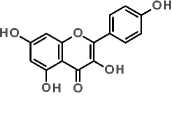
кемпферол-3-O-рутинозид
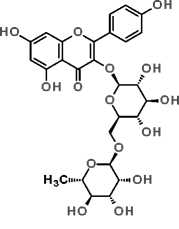
Рисунок 2. Кемпферол и некоторые его гликозиды
кемпферол-3-O-D-галактозид
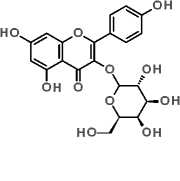
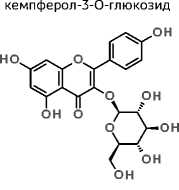
кемпферол-3-O-рамнозид
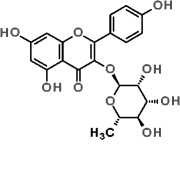
ные эффекты флавоноида, вероятно, обусловлены блокадой активации NF-κB и, как следствие, усилением регуляции провоспалительных генов. К тому же García-Mediavilla и соавт. установили, что при применении кемпферола в клетках печени Chang происходит снижение синтеза С-реактив-ного белка, циклокосигеназы 2-го типа и оксида азота. Стоит отметить, что оксид азота снижает активность многих ферментов, в частности каталазы, что приводит к накоплению в клетках пероксида азота. Также оксид азота взаимодействует с супероксидным анионом, который продуцирует пероксинитрит, повреждающий ДНК и ингибирующий митохондриальное дыхание [56]. В ходе фито-химических исследований плодов Morinda citrifolia был выделен кемпферол, который ингибировал 5- и 15-липоксигеназу. Данные ферменты играют важную роль в дериватизации лейкотриенов, принимающих участие в патогенезе различных воспалительных заболеваний, например, ревматоидного артрита, астмы и воспалительных заболеваний кишечника [57]. Имеются данные литературы, согласно которым кемпферол значительно ингибирует индуцируемую липополисахаридами продукцию хемокина моноцитарного происхождения, интерферон-гамма-индуцируемого белка 10 и интерлейкина-8 в клеточной линии моноцитарных клеток человека THP-1. Установлено, что полифенольное соединение способно подавлять индуцируемые липополисахаридами пути мито-ген-активируемой протеинкиназы, Т-хелперы 1, Т-хелперы 2 и продукцию хемокинов, связанных с нейтрофилами, в моноцитах, возможно, через пути митоген-активируемой протеинкиназы [58]. По результатам оценки противовоспалительного потенциала кемпферол был предложен в качестве нового терапевтического средства для лечения ревматоидного артрита. Флавоноид ингибировал пролиферацию стимулированных интерлейки-ном-1β синовиальных фибробластов, а также выработку металлопротеиназ, циклооксигеназу второго типа и простагландина Е2, участвующих в воспалении и разрушении суставов при ревматоидном артрите [59]. Изучение активности кемпферола в отношении тучных клеток, культивируемых из пуповинной крови человека, позволило выявить, что флавоноид ингибирует высвобождение из них провоспалительных цитокинов и ферментов: интерлейкина-6, интерлейкина-8, фактора некроза опухоли, гистамина и триптазы. Флавоноид подавляет повышение уровня внутриклеточного иона кальция и ингибирует фосфорилирование нечувствительной к кальцию протеинкиназы С, что обуславливает IgE-опосредованное высвобождение провоспалительных медиаторов из тучных клеток [60]. Полифенольное соединение снижало уровни эотаксина-1 и CCR3 рецептора эотаксина в тканях дыхательных путей. Тем самым кемпферол ослаблял воспаление дыхательных путей посредством модуляции передачи сигналов Tyk2-STAT1/3, реагирующих на интерлейкин-8, в эпителии дыхательных путей, подверженном воздействию эндотоксина, у мышей с астмой [61]. Пероральное введение кемпферола ослабляло повышенную экспрессию эотаксина-1 и основного белка эозинофилов в эпителии BEAS-2B дыхательных путей человека путем блокады трансактивации NF-κB, тем самым уменьшая накопление эозинофилов в дыхательных путях и легочной ткани. Флавоноид ослаблял TNF-α-индуцированную экспрессию эпителиальной внутриклеточной молекулы клеточной адгезии 1 и интегрина-β2 эозинофилов, затрудняя таким образом взаимодействие эозинофилов с эпителием дыхательных путей. Также он замедлял воспаление дыхательных путей, вызванное TNF-α, путем ослабления транскрипции моноцитарного хемоаттрактантного белка-1, возможно, из-за нарушения передачи сигналов NF-κB. Это позволяет рассматривать данный флавоноид как терапевтическое средство при лечении аллергических и воспалительных заболеваний дыхательных путей [62]. Кемпферол может снижать возрастное увеличение активности NF-κB и зависящей от NF-κB активности провоспалительных генов за счет ингибирования возрастной никотинамидадениндину-клеотидфосфатоксидазы [63]. Постишемическая терапия кемпферол-3-О-рутинозидом и кемпфе-рол-3-О-глюкозидом предотвращает ишемическое повреждение головного мозга и нейровоспаление путем ингибирования активации STAT3 и NF-κB и обладает терапевтическим потенциалом при заболеваниях, связанных с нейровоспалением
-
[64]. Lee и соавт. пришли к выводу, что кемпферол может быть полезен для лечения воспалительных заболеваний, в патогенезе которых принимает участие TNF- α , так как он блокируют активацию промотора интерлейкина-8, индуцированного TNF- α , и экспрессию генов в клетках HEK 293. Также флавоноид снижал выработку активных форм кислорода в ответ на воздействие TNF- α [65].
Таким образом, кемпферол воздействует на разнообразные каскады провоспалительных и воспалительных процессов, что позволяет рассматривать его в качестве перспективного соединения для комплексной терапии воспалительных процессов, в том числе и при аллергических проявлениях у человека.
Противоопухолевая активность
Кемпферол проявляет также противораковую активность [66]. Так, например, флавоноид может индуцировать апоптоз в клетках карциномы легких человека H460 в результате повышения внутриклеточного уровня аденозинтрифосфата и конденсации ДНК. При этом фиксируется экспрессия индуцирующего апоптоз фактора и каспазы-3 [67]. Данный флавоноид снижает экспрессию клау-дина-2 в клетках аденокарциномы легкого A549, что опосредовано ингибированием связывания STAT3 с промоторной областью клаудина-2 [68]. Установлено, что активация MEK-MAPK является необходимым условием для индуцируемого кемпферолом механизма клеточной гибели в раковых клетках A549, что дополняет молекулярные механизмы терапии рака легкого [69]. Кемпферол эффективно ингибирует поглощение глюкозы клетками MCF-7, предположительно путем влияния на GLUT1. Этот биологический эффект опосредует антипролиферативное и цитотоксическое действие флавоноида в отношении клеточной линии рака молочной железы человека MCF-7 [70]. Также по-лифенольное соединение подавляет пролиферацию и вызывает остановку клеточного цикла, апоптоз и повреждение ДНК в клетках рака молочной железы MDA-MB-231. При этом происходит увеличение уровня экспрессии γH2AX, каспазы-9, каспазы-3 и p-ATM по сравнению с контрольной группой [71]. Установлено, что низкая доза кемпферола подавляет миграцию и инвазию клеток рака молочной железы MDA-MB-231 путем ингибирования активности RhoA и Rac1 [72]. Кемпферол-3-О-рамнозид, выделенный из листьев Schima wallichii Korth, ингибирует пролиферацию клеток рака молочной железы MCF-7 посредством активации передачи сигналов каспаз [73]. Противоонкологи-ческое действие флавоноида в отношении клеток рака молочной железы MCF-7 и ксенотрансплантата, индуцированное эстрогеном и триклозаном, может быть связано с его способностью подавлять экспрессию белков pIRS-1, pAkt и pMEK1 [74]. Кемпферол ингибирует пролиферацию клеток рака молочной железы человека MDA-MB-453 путем нарушения клеточного цикла и индукции апоптоза через фосфорилирование р53 [75].
Один из молекулярных механизмов апоптоза клеток глиомы головного мозга человека кемпферолом опосредуется через каспазозависимые механизмы, включающие подавление регуляции XIAP и сурвивина с помощью внеклеточной сигнальнорегулируемой киназы и Akt [76]. Siegelin и соавт. дополнили молекулярные механизмы апоптоза клеток глиомы человека под действием кемпферола, показав протеасомную деградацию сурвиви-на, что выделяет этот каскад биохимический реакций в качестве молекулярной мишени для поиска новых лекарственных средств [77]. Флавоноид также индуцировал гибель клеток глиобластомы путем снижения экспрессии Bcl-2 и изменения мембранного потенциала митохондрий с повышенной экспрессией активной каспазы-3 и расщепленной поли-(АДФ-рибоза)-полимеразы. К тому же наблюдалось подавление провоспалительного интерлейкина-6, интерлейкина-8, моноцитарного хемоаттрактантного белка-1, а апоптоз клеток связан главным образом с повышенной генерацией активных форм кислорода, сопровождающейся снижением содержания агентов, нейтрализующих окислители, таких как супероксиддисмутаза и тио-редоксин [78]. В рамках поиска новых подходов доставки терапевтических агентов в головной мозг была разработана мукоадгезивная наноэмульсия с добавлением кемпферола для интраназального введения, которая согласна исследованиям in vitro, способна уменьшат рост глиомы [79].
Обработка раковых клеток гепатомы Huh7 кемпферолом в условиях гипоксии (1% кислорода) эффективно ингибировала активность HIF-1 дозозависимым образом, что объясняется инактивацией p44/42 MAPK [80]. В клетках рака печени SK-HEP-1 флавоноид повышал уровни белков p-AMPK, LC3-II, Atg-5, Atg-7, Atg-12 и беклина-1, ингибировал уровни белка CDK1, циклина-B, p-AKT и p-mTOR, а также вызывал остановку клеточного цикла G2/M через подавление CDK1/циклина-B, что может быть полезно для долгосрочной профилактики рака [81]. Комбинированное лечение кемпферолом резко индуцировало апоптоз в раковых клетках толстой кишки человека SW480. Полифенольное соединение заметно повышает хемочувствительность рецепторов DR4 и DR5 [82]. Запуск апоптических каскадов кемпферолом в клеточной линии рака толстой кишки человека HCT116 свидетельствует о высокой мультитаргет-ной противораковой активности. Это действие опосредуется высвобождением цитохрома С из митохондрий и активизацией каспазы-3, а также связано со стимулированием фосфорилирования ATM и H2AX [83]. В ходе исследований выявлено, что кемпферол активирует иммунный ответ в клетках рака предстательной железы, стимулируя выработку гранулоцитарно-макрофагального колониестимулирующего фактора [84]. Противораковый эффект кемпферола в отношении раковых клеток поджелудочной железы Miapaca-2, Panc-1 и SNU-213 был опосредован ингибированием связанных с EGFR путей Src, ERK1/2 и AKT [85]. Wu и соавт. зафиксировали, что флавоноид индуцирует повреждение ДНК и ингибирует экспрессию белка, связанного с репарацией ДНК, в клетках промиелоцитарного лейкоза HL-60 человека [86]. Кемпферол может тормозить развитие остеосаркомы человека в связи с его способностью индуцировать апоптоз раковых клеток через стресс эндоплазматического ретикулума и митохондриально-зависимый путь [87]. Таким образом, анализ данных литературы показывает, что кемпферол, как и кверцетин, проявляет противоопухолевую активность, что позволяет рекомендовать его для комплексной терапии злокачественных заболеваний.
Влияние на сердечно-сосудистую систему
Полифенольное соединение в дозе около 500 мг оказывает благоприятное влияние, снижая кровяное давление и ингибируя воспаление [88]. Также кемпферол ослабляет воспаление фибробластов сердца путем подавления активации NF- κ B и Akt, что обуславливает его кардиопротекторный эффект [89]. Кроме того, кардиопротекция может быть связана с антиоксидантным действием и ингибированием активности GSK-3 β [90], а также может быть результатом влияния на продукцию оксида азота и снижения уровня асимметричного диметиларгинина [91]. Флавоноид обладает способностью уменьшать или предотвращать тромботические осложнения за счет различных биохимических каскадов [92].
ЗАКЛЮЧЕНИЕ
Из проанализированных данных литературы следует, что кверцетин и кемпферол являются перспективными природными полифенольными соединениями с широкой биологической активностью, что обусловливает их ценность для более углубленных фармакологических исследований и разработки на их основе новых передовых лекарственных препаратов. Ядра данных флавоноидов можно рекомендовать для химической модификации с целью получения высокоактивных соединений с антиоксидантной, противоаллергической, противовоспалительной, кардиопротекторной и противоопухолевой активностью.
Финансирование: Авторы заявляют об отсутствии финансирования.
Список литературы Обзор биологической активности флавоноидов: кверцетина и кемпферола
- Теплова В. В., Исакова Е. П., Кляйн О. И. и др. Природные полифенолы: биологическая активность, фармакологический потенциал, пути метаболической инженерии (обзор) // Прикладная биохимия и микробиология. 2018. Т. 54. № 3. С. 215-235. [Teplova VV, Isakova EP, Klein OL, et al. Natural polyphenols: biological activity, pharmacological potential, the ways of metabolic engineering (review). Applied Biochemistry and Microbiology. 2018;54(3):215-235 (in Russ.)]. DOI: 10.7868/S0555109918030017. EDN: XOTZOP
- Куркин В. А., Куркина А. В., Авдеева Е. В. Флавоноиды как биологически активные соединения лекарственных растений // Фундаментальные исследования. 2013. № 11-9. С. 1897-1901. [Kurkin VA, Kurkina AV, Avdeeva EV. The flavonoids as biologically active compounds of medicinal plants. Fundamental research. 2013;11-9:1897-1901 (in Russ.)]. EDN: RWHBST
- Li Y, Yao J, Han C, et al. Quercetin, Inflammation and Immunity. Nutrients. 2016;8(3):167. DOI: 10.3390/ nu8030167
- Dias MC, Pinto DCGA, Silva AMS. Plant Flavonoids: Chemical Characteristics and Biological Activity. Molecules. 2021;26(17):5377. DOI: 10.3390/molecules26175377
- Ross JA, Kasum CM. Dietary flavonoids: Bioavailability, Metabolic Effects, and Safety. Annual Review of Nutrition. 2002;22(1):19-34. DOI: 10.1146/annurev. nutr. 22.111401.144957
- Bouktaib M, Atmani A, Rolando C. Regio- and stereoselective synthesis of the major metabolite of quercetin, quercetin-3-O-e-d-glucuronide. Tetrahedron Letters. 2002;43(35):6263-6266. DOI: 10.1016/s0040-4039(02)01264-9
- Меньщиков Е. Б., Ланкин В. З., Зенков Н. К., и др. Окислительный стресс. Прооксиданты и антиоксиданты. Москва: Слово, 2006. 556 с. [Menschikov EB, Lankin VZ, Zenkov NK, et al. Okislitelniistress. Prooksidanti i antioksidanti (Oxidative stress. Pro-oxidants and antioxidants). Moscow: Slovo, 2006. 556 p. EDN: QZDBBX
- Xu D, Hu M-J, Wang Y-Q, et al. Antioxidant Activities of Quercetin and Its Complexes for Medicinal Application. Molecules. 2019;24(6):1123. DOI: 10.3390/molecules24061123.
- Zhang M, Swartz SG, Yin L, et al. Antioxidant Properties of Quercetin. Advances in Experimental Medicine and Biology. 2011;701:283-298. DOI: 10.1007/978-1-4419-7756-4_3
- Robaszkiewicz A, Balcerczyk A, Bartosz G. Antioxidative and prooxidative effects of quercetin on A549 cells. Cell Biology International. 2007;31:1245-1250. DOI: 10.1016/j.cellbi.2007.04.009
- Lakhanpal P, Rai DK. Quercetin: a versatile flavonoid. Internet Journal of Medical Update. 2007;2(2):22-37
- Bahorun T, Soobrattee MA, Luximon-Ramma V, et al. Free radicals and antioxidants in cardiovascular health and disease. Internet Journal of Medical Update. 2006;1(2):25-41
- Braun KF, Ehnert S, Freude T, et al. Quercetin Protects Primary Human Osteoblasts Exposed to Cigarette Smoke through Activation of the Antioxidative Enzymes HO-1 and SOD-1. The Scientific World Journal. 2011;11:2348-2357. DOI: 10.1100/2011/471426
- Murakami A, Ashida H, Terao J. Multi targeted cancer prevention by quercetin. Cancer Letters. 2008;269(2):315-325. DOI: 10.1016/j.canlet.2008.03.046
- Tezerji S, Abdolazimi H, Fallah A, et al. The effect of resveratrol and quercetin intervention on azoxymeth-ane-induced colon cancer in Rats model. Clinical Nutrition Open Science. 2022;45:91-102. DOI: 10.1016/j. nutos.2022.01.008
- Li Q-C, Liang Y, Hu G-R, et al. Enhanced therapeutic efficacy and amelioration of cisplatin-induced nephro-toxicity by quercetin in 1,2-dimethyl hydrazine-induced colon cancer in rats. Indian Journal of Pharmacology. 2016;48(2):168-171. DOI: 10.4103/0253-7613.178834
- Kim GT, Lee SH, Kim JI, et al. Quercetin regulates the sestrin 2-AMPK-p38 MAPK signaling pathway and induces apoptosis by increasing the generation of intracellular ROS in a p53-independent manner. International Journal of Molecular Medicine. 2014;33:863-869. DOI: 10.3892/ijmm.2014.1658
- Liao H, Bao X, Zhu J, et al. O-Alkylated derivatives of quercetin induce apoptosis of MCF-7 cells via a caspase-independent mitochondrial pathway. Chemico-Biological Interactions. 2015;242:91-98. DOI: 10.1016/j.cbi.2015.09.022
- Li S-Z, Qiao S-F, Zhang J-H, et al. Quercetin Increase the Chemosensitivity of Breast Cancer Cells to Doxorubicin Via PTEN/Akt Pathway. Anti-Cancer Agents in Medicinal Chemistry. 2015;15(9). DOI: 10.217 4/1871520615999150121121708
- Tao S-F, He H-F, Chen Q. Quercetin inhibits proliferation and invasion acts by up-regulating miR-146a in human breast cancer cells. Mol Cell Biochem. 2015;402:93-100. DOI: 10.1007/s11010-014-2317-7
- Kim MC, Lee HJ, Lim B, et al. Quercetin induces apoptosis by inhibiting MAPKs and TRPM7 channels in AGS cells. International Journal of Molecular Medicine. 2014;33: 1657-1663. DOI: 10.3892/ijmm.2014.1704
- Nwaeburu CC, Bauer N, Zhao Z, et al. Up-regulation of microRNA let-7c by quercetin inhibits pancreatic cancer progression by activation of Numbl. Oncotarget. 2016;7:58367-58380. DOI: 10.18632/oncotarget. 11122
- Appari M, Babu KR, Kaczorowski A, et al. Sulforaphane, quercetin and catechins complement each other in elimination of advanced pancreatic cancer by miR-let-7 induction and K-ras inhibition. International Journal of Oncology. 2014;45:1391-1400. DOI: 10.3892/ijo.2014.2539
- Mandal AK, Ghosh D, Sarkar S, et al. Nanocapsulated quercetin downregulates rat hepatic MMP-13 and controls diethylnitrosamine-induced carcinoma. Nanomedicine. 2014;9(15):2323-2337. DOI: 10.2217/ nnm.14.11
- Zhao P, Mao J-M, Zhang S-Y, et al. Quercetin induces HepG2 cell apoptosis by inhibiting fatty acid biosynthesis. Oncology Letters. 2014;8(2):765-769. DOI: 10.3892/ol.2014.2159
- Orsolic N, Car N. Quercetin and hyperthermia modulate cisplatin-induced DNA damage in tumor and normal tissues in vivo. Tumor Biology. 2014;35(7):6445-6454. DOI: 10.1007/s13277-014-1843-y
- Kuhar M, Sen S, Singh N. Role of mitochondria in quercetin-enhanced chemotherapeutic response in human non-small cell lung carcinoma H-520 cells. Anticancer Res. 2006;26(2A):1297-1303
- Zhao X, Zhang J. Mechanisms for quercetin in prevention of lung cancer cell growth and metastasis. Journal of Central South University (Medical Science) 2015;40(6):592-597. DOI: 10.11817/j.issn.1672-7347.2015.06.004
- Mason V, Calgarotto AK, Franchi GC, et al. Multi target Effects of Quercetin in Leukemia. Cancer Prevention Research. 2014;7(12):1240-1250. DOI: 10.1158/1940-6207.capr-13-0383
- Santos BL, Oliveira MN, Coelho PL, et al. Flavonoids suppress human glioblastoma cell growth by inhibiting cell metabolism, migration, and by regulating extracellular matrix proteins and metalloproteinases expression. Chemico-Biological Interactions. 2015;242:123-138. DOI: 10.1016/j.cbi.2015.07.014
- Rauf A, Imran M, Khan IA, et al. Anticancer potential of quercetin: A comprehensive review. Phytotherapy Research. 2018;32(11):2109-2130. DOI: 10.1002/ptr.6155
- Mlcek J, Jurikova T, Skrovankova S, et al. Quercetin and Its Anti-Allergic Immune Response. Molecules. 2016;21(5):623. DOI: 10.3390/molecules21050623
- Jurikova T, Mlcek J, Sochor J, et al. Polyphenols and their Mechanism of Action in Allergic Immune Response. Glob J Allergy. 2015;1(2):37-39. DOI: 10.17352/2455-8141.000008.
- Gröber U. Micronutrients: Metabolic Tuning — Prevention — Therapy. Drug Metabolism and Drug Interactions. 2009;24(2-4):331. DOI: 10.1515/dmdi.2009.24.2-4.331
- Finn DF, Walsh JJ. Twenty-first century mast cell stabilizers. British Journal of Pharmacology. 2013;170(1):23-37. DOI: 10.1111/bph.12138
- Nair MP, Kandaswami C, Mahajan S, et al. The flavonoid, quercetin, differentially regulates Th-1 (IFNy) and Th-2 (IL4) cytokine gene expression by normal peripheral blood mononuclear cells. Biochimica et Biophysica Acta (BBA). Molecular Cell Research. 2002;1593(1):29-36. DOI: 10.1016/s0167-4889(02) 00328-2
- Weng Z, Zhang B, Asadi S, et al. Quercetin Is More Effective than Cromolyn in Blocking Human Mast Cell Cytokine Release and Inhibits Contact Dermatitis and Photosensitivity in Humans. PLoS ONE. 2012;7(3):e33805. DOI: 10.1371/journal.pone.0033805
- Kimata M, Shichijo M, Miura T, et al. Effects of luteolin, quercetin and baicalein on immunoglobulin E-mediated mediator release from human cultured mast cells. Clinical Experimental Allergy. 2000;30(4):501-508. DOI: 10.1046/j.1365-2222.2000.00768. x
- Chirumbolo S. The Role of Quercetin, Flavonols and Flavones in Modulating Inflammatory Cell Function. Inflammation & Allergy. Drug Targets. 2010;9(4):263-285. DOI: 10.2174/187152810793358741
- Oliveira TT, Campos KM, Cerqueira-Lima AT, et al. Potential therapeutic effect of Allium cepa L. and quercetin in a murine model of Blomia tropicalis induced asthma. DARU Journal of Pharmaceutical Sciences. 2015;23(1). DOI: 10.1186/s40199-015-0098-5
- Edwards RL, Lyon T, Litwin SE, et al. Quercetin Reduces Blood Pressure in Hypertensive Subjects. The Journal of Nutrition. 2007;137(11):2405-2411. DOI: 10.1093/jn/137.11.2405
- Liu H, Guo X, Hu Y, et al. Heart protective effects and mechanism of quercetin preconditioning on antimyocardial ischemia reperfusion (IR) injuries in rats. Gene. 2014;545(1):149-155. DOI: 10.1016/j.gene.2014.04.043
- Bhat IUH, Bhat R. Quercetin: A Bioactive Compound Imparting Cardiovascular and Neuroprotective Benefits: Scope for Exploring Fresh Produce, Their Wastes, and By-Products. Biology. 2021;10(7):586. DOI: 10.3390/biology10070586
- Chen AY, Chen YC. A review of the dietary flavonoid, kaempferol on human health and cancer chemopre-vention. Food Chemistry. 2013;138(4):2099-2107. DOI: 10.1016/j.foodchem.2012.11.139
- Imran M, Rauf A, Shah ZA, et al. Chemopreventive and therapeutic effect of the dietary flavonoid kaempferol: A comprehensive review. Phytotherapy Research. 2018;1-13. DOI: 10.1002/ptr.6227
- Calderón-Montaño JM, Burgos-Morón E, Pérez-Guerrero C, López-Lázaro M. A review on the dietary flavonoid kaempferol. Mini Rev Med Chem. 2011;11(4):298-344. DOI: 10.2174/138955711795305335
- Devi KP, Malar DS, Nabavi SF, et al. Kaempferol and inflammation: From chemistry to medicine. Pharmacological Research. 2015:99:1-10. DOI: 10.1016/j.phrs.2015.05.002
- Galati G. Prooxidant activity and cellular effects of the phenoxyl radicals of dietary flavonoids and other polyphenolics. Toxicology. 2002.177(1):91-104. DOI: 10.1016/s0300-483x(02)00198-1
- Winterbourn CC. Reconciling the chemistry and biology of reactive oxygen species. Nature Chemical Biology. 2008;4 (5):278-286. DOI: 10.1038/nchembio.85
- Vellosa JCR, Regasini LO, Khalil NM, et al. Antioxidant and cytotoxic studies for kaempferol, quercetin and isoquercitrin. Eclética Química. 2011;36 (2):7-20. DOI: 10.1590/s0100-46702011000200001
- Hyun SK, Jung HA, Chung HY, et al. In vitro peroxynitrite scavenging activity of 6-hydroxykynurenic acid and other flavonoids from Ginkgo biloba yellow leaves. Archives of Pharmacal Research. 2006;29(12):1074-1079. DOI: 10.1007/bf02969294
- Saw CLL, Guo Y, Yang AY, et al. The berry constituents quercetin, kaempferol, and pterostilbene syner-gistically attenuate reactive oxygen species: Involvement of the Nrf2-ARE signaling pathway. Food and Chemical Toxicology. 2014;72:303-311. DOI: 10.1016/j.fct.2014.07.038
- Park JS, Rho HS, Kim DH, et al. Enzymatic Preparation of Kaempferol from Green Tea Seed and Its Antioxidant Activity. Journal of Agricultural and Food Chemistry. 2006;54(8):2951-2956. DOI: 10.1021/jf052900a
- Tzeng C-W, Yan F-L, Wu T-H, et al. Enhancement of Dissolution and Antioxidant Activity of Kaempferol Using a Nanoparticle Engineering Process. Journal of Agricultural and Food Chemistry. 2011;59(9):5073-5080. DOI: 10.1021/jf200354y
- Lee J-H, Kim G-H. Evaluation of Antioxidant and Inhibitory Activities for Different Subclasses Flavonoids on Enzymes for Rheumatoid Arthritis. Journal of Food Science. 2010;75(7):H212-H217. DOI: 10.1111/j.1750-3841.2010.01755. x
- Garcia-Mediavilla V, Crespo I, Collado PS, et al. The anti-inflammatory flavones quercetin and kaempferol cause inhibition of inducible nitric oxide synthase, cyclooxygenase-2 and reactive C-protein, and down-regulation of the nuclear factor kappaB pathway in Chang Liver cells. European Journal of Pharmacology. 2007;557(2-3):221-229. DOI: 10.1016/j.ejphar.2006.11.014
- Deng S, Palu AK, West BJ, et al. Lipoxygenase Inhibitory Constituents of the Fruits of Noni (Morinda citrifo-lia) Collected in Tahiti. Journal of Natural Products. 2007;70(5):859-862. DOI: 10.1021/np0605539
- Huang C-H, Jan R-L, Kuo C-H, et al. Natural Flavone Kaempferol Suppresses Chemokines Expression in Human Monocyte THP-1 Cells through MAPKPathways. Journal of Food Science. 2010;75(8):H254-H259. DOI: 10.1111/j.1750-3841.2010.01812.x
- Yoon H-Y, Lee E-G, Lee H, et al. Kaempferol inhibits IL-1ß-induced proliferation of rheumatoid arthritis synovial fibroblasts and the production of COX-2, PGE2 and MMPs. International Journal of Molecular Medicine. 2013;32(4):971-977. DOI: 10.3892/ijmm.2013.1468
- Kempuraj D, Madhappan B, Christodoulou S, et al. Flavonols inhibit proinflammatory mediator release, intracellular calcium ion levels and protein kinase C theta phosphorylation in human mast cells. British Journal of Pharmacology. 2005;145(7):934-944. DOI: 10.1038/sj.bjp.0706246
- Gong J-H, Shin D, Han S-Y, et al. Blockade of Airway Inflammation by Kaempferol via Disturbing Tyk-STAT Signaling in Airway Epithelial Cells and in Asthmatic Mice. Evidence-Based Complementary and Alternative Medicine. 2013;2013:1-13. DOI: 10.1155/2013/250725
- Gong J-H, Shin D, Han S-Y, et al. Kaempferol Suppresses Eosinophil Infiltration and Airway Inflammation in Airway Epithelial Cells and in Mice with Allergic Asthma. The Journal of Nutrition. 2011;142(1):47-56. DOI: 10.3945/jn.111.150748
- Kim JM, Lee EK, Kim DH, et al. Kaempferol modulates pro-inflammatory NF-kB activation by suppressing advanced glycation endproducts-induced NADPH oxidase. AGE. 2010;32(2):197-208. DOI: 10.1007/ s11357-009-9124-1
- Yu L, Chen C, Wang L-F, et al. Neuroprotective Effect of Kaempferol Glycosides against Brain Injury and Neuroinflammation by Inhibiting the Activation of NF-kB and STAT3 in Transient Focal Stroke. PLoS ONE. 2013;8(2):e55839. DOI: 10.1371/journal.pone.0055839
- Lee S-Y, Kim Y-J, Kwon S-H, et al. Inhibitory Effects of Flavonoids on TNF-a-Induced IL-8 Gene Expression in HEK293 Cells. Korean Society for Biochemistry and Molecular Biology — BMB Reports. 2009;42(5):265-270. DOI: 10.5483/bmbrep.2009.42.5.265
- Imran M, Salehi B, Sharifi-Rad J, et al. Kaempferol: A Key Emphasis to Its Anticancer Potential. Molecules. 2019;24(12):2277. DOI: 10.3390/molecules24122277
- Leung HW-C, Lin C-J, Hour M-J, et al. Kaempferol induces apoptosis in human lung non-small carcinoma cells accompanied by an induction of antioxidant enzymes. Food and Chemical Toxicology. 2007;45(10):2005-2013. DOI: 10.1016/j.fct.2007.04.023
- Sonoki H, Animals A, Endo S, et al. Kaempferol and Luteolin Decrease Claudin-2 Expression Mediated by Inhibition of STAT3 in Lung Adenocarcinoma A549 Cells. Nutrients. 2017;9(6):597. DOI: 10.3390/ nu9060597
- Nguyen TTT, Tran E, Ong CK, et al. Kaempferol-induced growth inhibition and apoptosis in A549 lung cancer cells is mediated by activation of MEK-MAPK. Journal of Cellular Physiology. 2003;197(1):110-121. DOI: 10.1002/jcp.10340
- Azevedo C, Correia-Branco A, Araujo JR, et al. The Chemopreventive Effect of the Dietary Compound Kaempferol on the MCF-7 Human Breast Cancer Cell Line Is Dependent on Inhibition of Glucose Cellular Uptake. Nutrition and Cancer. 2015;67(3):504-513. DOI: 10.1080/01635581.2015.1002625
- Zhu L, Xue L. Kaempferol Suppresses Proliferation and Induces Cell Cycle Arrest, Apoptosis, and DNA Damage in Breast Cancer Cells. Oncology Research Featuring Preclinical and Clinical Cancer Therapeutics. 2019;27(6):629-634. DOI: 10.3727/096504018x15228018559434
- Li S, Yang T, Deng R, et al. Low dose of kaempferol suppresses the migration and invasion of triple-negative breast cancer cells by downregulating the activities of RhoA and Racl. Onco Targets and Therapy. 2017;10:4809-4819. DOI: 10.2147/ott.s140886
- Diantini A, Subarnas A, Lestari K, et al. Kaempferol-3-O-rhamnoside isolated from the leaves of Schima wallichii Korth. inhibits MCF-7 breast cancer cell proliferation through activation of the caspase cascade pathway. Oncology Letters. 2012;3(5):1069-1072. DOI: 10.3892/ol.2012.596
- Kim S-H, Hwang K-A, Choi K-C. Treatment with kaempferol suppresses breast cancer cell growth caused by estrogen and triclosan in cellular and xenograft breast cancer models. The Journal of Nutritional Biochemistry. 2016;28:70-82. DOI: 10.1016/j. jnutbio.2015.09.027
- Choi EJ, Ahn WS. Kaempferol induced the apoptosis via cell cycle arrest in human breast cancer MDA-MB-453 cells. Nutrition Research and Practice. 2008;2(4):322. DOI: 10.4162/nrp.2008.2.4.322
- Jeong JC, Kim MS, Kim TH, et al. Kaempferol Induces Cell Death Through ERK and Akt-Dependent Down-Regulation of XIAP and Survivin in Human Glioma Cells. Neurochemical Research. 2008;34(5):991-1001. DOI: 10.1007/s11064-008-9868-5
- Siegelin MD, Reuss DE, Habel A, et al. The flavonoid kaempferol sensitizes human glioma cells to TRAIL-mediated apoptosis by proteasomal degradation of survivin. Molecular Cancer Therapeutics. 2008;7(11):3566-3574. DOI: 10.1158/1535-7163.mct-08-0236
- Sharma V, Joseph C, Ghosh S, et al. Kaempferol induces apoptosis in glioblastoma cells through oxidative stress. Molecular Cancer Therapeutics. 2007;6(9):2544-2553. DOI: 10.1158/1535-7163.mct-06-0788
- Colombo M, Figueiro F, de Fraga Draws A, et al. Kaempferol-loaded mucoadhesive nanoemulsion for intranasal administration reduces glioma growth in vitro. International Journal of Pharmaceutics. 2008;543(1-2);214-223. DOI: 10.1016/j.ijpharm.2018.03.055
- Mylonis I, Lakka A, Tsakalof A, et al. The dietary flavonoid kaempferol effectively inhibits HIF-1 activity and hepatoma cancer cell viability under hypoxic conditions. Biochemical and Biophysical Research Communications. 2010;398(1):74-78. DOI: 10.1016/j.bbrc.2010.06.038
- Huang W-W, Tsai S-C, Peng S-F, et al. Kaempferol induces autophagy through AMPK and AKT signaling molecules and causes G2/M arrest via downregulation of CDKl/cyclin B in SK-HEP-1 human hepatic cancer cells. International Journal of Oncology. 2013;42(6):2069-2077. DOI: 10.3892/ijo.2013.1909
- Yoshida T, Konishi M, Horinaka M, et al. Kaempferol sensitizes colon cancer cells to TRAIL-induced apoptosis. Biochemical and Biophysical Research Communications. 2008;375(1):129-133. DOI: 10.1016/j.bbrc. 2008.07.131
- Li W, Du B, Wang T, et al. Kaempferol induces apoptosis in human HCT116 colon cancer cells via the Ataxia-Telangiectasia Mutated-p53 pathway with the involvement of p53 Upregulated Modulator of Apoptosis. Chemico-Biological Interactions. 2009;177(2):121-127. DOI: 10.1016/j.cbi.2008.10.048
- Bandyopadhyay S, Romero JR, Chattopadhyay N. Kaempferol and quercetin stimulate granulocyte-macrophage colony-stimulating factor secretion in human prostate cancer cells. Molecular and Cellular Endocrinology. 2008;287(1-2):57-64. DOI: 10.1016/j.mce.2008.01.015
- Lee J, Kim JH. Kaempferol Inhibits Pancreatic Cancer Cell Growth and Migration through the Blockade of EGFR-Related Pathway In Vitro. PLOS ONE. 2016;11(5):e0155264. DOI: 10.1371/journal.pone.0155264
- Wu L-Y, Lu H-F, Chou Y-C, et al. Kaempferol Induces DNA Damage and Inhibits DNA Repair Associated Protein Expressions in Human Promyelocytic Leukemia HL-60 Cells. The American Journal of Chinese Medicine. 2015;43(02):365-382. DOI: 10.1142/s0192415x1550024x
- Huang W-W, Chiu Y-J, Fan M-J, et al. Kaempferol induced apoptosis via endoplasmic reticulum stress and mitochondria-dependent pathway in human osteosarcoma U-2 OS cells. Molecular Nutrition & Food Research. 2010;54(11):1585-1595. DOI: 10.1002/mnfr.201000005
- Dabeek WM, Marra MV. Dietary Quercetin and Kaempferol: Bioavailability and Potential Cardiovascular-Related Bioactivity in Humans. Nutrients. 2019;11(10):2288. DOI: 10.3390/nu11102288
- Tang X, Liu J, Dong W, et al. Protective Effect of Kaempferol on LPS plus ATP-Induced Inflammatory Response in Cardiac Fibroblasts. Inflammation. 2014;38(1):94-101. DOI: 10.1007/s10753-014-0011-2
- Zhou M, Ren H, Han J, et al. Protective Effects of Kaempferol against Myocardial Ischemia/Reperfusion Injury in Isolated Rat Heart via Antioxidant Activity and Inhibition of Glycogen Synthase Kinase-3ß. Oxidative Medicine and Cellular Longevity. 2015;2015:1-8. DOI: 10.1155/2015/481405
- Xiao H-B, Jun-Fang, Lu X-Y, et al. Protective effects of kaempferol against endothelial damage by an improvement in nitric oxide production and a decrease in asymmetric dimethylarginine level. European Journal of Pharmacology. 2009;616(1-3):213-222. DOI: 10.1016/j.ejphar.2009.06.022
- Choi J-H, Park S-E, Kim S-J, et al. Kaempferol inhibits thrombosis and platelet activation. Biochimie. 2015;115:177-186. DOI: 10.1016/j.biochi.2015.06.001

